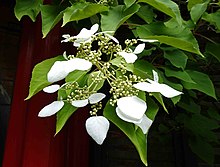Hydrangeaceae
| Hydrangeaceae | |
|---|---|
 | |
| Hydrangea macrophylla, a member of the subfamily Hydrangeoideae | |
 | |
| Fendlera rupicola, a member of the subfamily Jamesioideae | |
| Scientific classification | |
| Kingdom: | Plantae |
| Clade: | Tracheophytes |
| Clade: | Angiosperms |
| Clade: | Eudicots |
| Clade: | Asterids |
| Order: | Cornales |
| Family: | Hydrangeaceae Dumort.[1] |
| Genera | |
| See text | |
| Synonyms[2] | |
| |

Hydrangeaceae is a family of flowering plants in the order Cornales, with a wide distribution in Asia and North America, and locally in southeastern Europe.[3]
Description
The genera are characterised by leaves in opposite pairs (rarely whorled or alternate), and regular, bisexual flowers with four (rarely 5–12) petals. The fruit is a capsule or berry containing several seeds, the seeds with a fleshy endosperm.[4]
Genera
The following genera are accepted:[5]
- Carpenteria Torr.
- Deutzia Thunb.
- Fendlera Engelm. & A.Gray
- Fendlerella A.Heller
- Hydrangea Gronov. ex L.
- Jamesia Torr. & A.Gray
- Kirengeshoma Yatabe
- Philadelphus L.
- Whipplea Torr.
Phylogeny
The family Hydrangeaceae has two subfamilies, namely Jamesioideae and Hydrangeoideae. The subfamily Jamesioideae comprises the genera Jamesia and Fendlera.[6][7] They are the sister group to the remaining Hydrangeaceae.[7][8] The subfamily Hydrangeoideae has two tribes:[9][7][8] Hydrangeae consists of Hydrangea s.l.,[9] and Philadelpheae consists of Philadelphus, Carpenteria, Deutzia, Kirengeshoma, Whipplea, and Fendlerella.[7][8] Carpenteria is the sister group to Philadelphus. Deutzia is the sister group to Kirengeshoma, and Fendlerella is the sister group to Whipplea.[8][6][7] However the relationships among those three clades within the tribe Philadelphae are a bit unclear.[8] The following cladogram summarizes results from different studies, and for each node it is noted which studies support the sister group positions of the following branches:
References
- ^ Angiosperm Phylogeny Group (2009). "An update of the Angiosperm Phylogeny Group classification for the orders and families of flowering plants: APG III". Botanical Journal of the Linnean Society. 161 (2): 105–121. doi:10.1111/j.1095-8339.2009.00996.x. hdl:10654/18083.
- ^ "Family: Hydrangeaceae Dumort., nom. cons". Germplasm Resources Information Network. United States Department of Agriculture. 2003-01-17. Retrieved 2012-07-31.
- ^ Christenhusz, M. J. M.; Byng, J. W. (2016). "The number of known plants species in the world and its annual increase". Phytotaxa. 261 (3): 201–217. doi:10.11646/phytotaxa.261.3.1.
- ^ "Hydrangeaceae - FNA". floranorthamerica.org. Retrieved 2023-06-20.
- ^ "Hydrangeaceae Dumort". Plants of the World Online. Board of Trustees of the Royal Botanic Gardens, Kew. Retrieved 30 June 2021.
- ^ a b c d e f Kim, C., Deng, T., Wen, J., Nie, Z. L., & Sun, H. (2015). "Systematics, biogeography, and character evolution of Deutzia (Hydrangeaceae) inferred from nuclear and chloroplast DNA sequences." Molecular Phylogenetics and Evolution, 87, 91-104.
- ^ a b c d e f g h i j k l m n Hufford, L., Moody, M. L., & Soltis, D. E. (2001). "A phylogenetic analysis of Hydrangeaceae based on sequences of the plastid gene matK and their combination with rbcL and morphological data." International Journal of Plant Sciences, 162(4), 835-846.
- ^ a b c d e f g h i j k Kubitzki, K. (2013). "Flowering Plants. Dicotyledons: Celastrales, Oxalidales, Rosales, Cornales, Ericales." p. 206. Springer Berlin Heidelberg.
- ^ a b c d Samain, M. S., Wanke, S., & Goetghebeur, P. (2010). "Unraveling extensive paraphyly in the genus Hydrangea s.l. with implications for the systematics of tribe Hydrangeeae." Systematic Botany, 35(3), 593-600.
- v
- t
- e
- Supergroup Plant:
- Bryophyta
- Marchantiophyta
- Polypodiophyta
- Acrogymnospermae
- Angiospermae
| Amborellales | |
|---|---|
| Nymphaeales | |
| Austrobaileyales |
 Category
Category
 | This article about plants of the order Cornales is a stub. You can help Wikipedia by expanding it. |
- v
- t
- e











